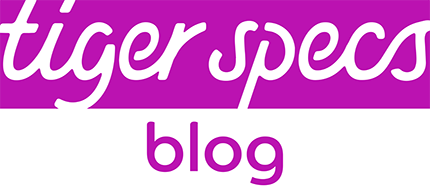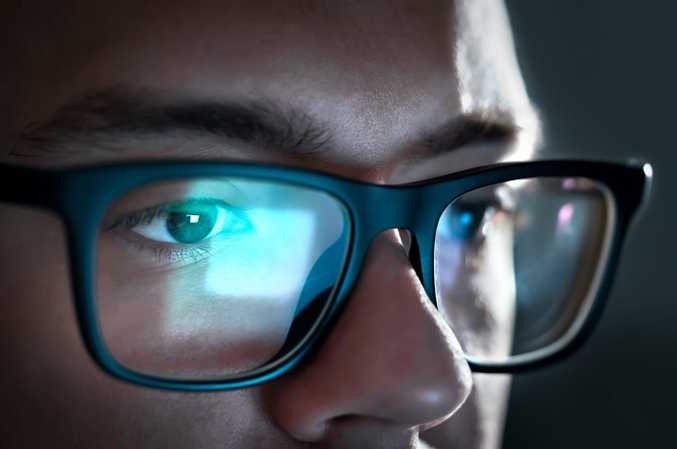What exactly are Blue Light Glasses? How may we all benefit from wearing them? We hear you ask…
“I’d heard of Blue Light Blocking Glasses before: they were yellow, ugly and not worth the laughter I would get from both roommates and fellow workers if I wore them regularly.” Gina Tomaine recently wrote in ‘Good House Keeping’ Magazine.
Firstly…
What is Blue Light?
What we see – the visible spectrum of light – consists of a range of colours, from blue-violet on the lower end to red on the higher end. Light on the lowest end of the visible spectrum has the shortest wave lengths (blue-violet colours); light on the highest end has the longest wavelengths (red). Since shorter wavelengths emit more energy, blue light is also known as High Energy Visible (HEV) Light and is all around us, from the sun, to our screen technology to some artificial lighting and this is what is filtered out by Blue Light Blocking Glasses.
How are we exposed to HEV or Blue Light?
We all know the dangers of sun exposure. That glorious bright sunny day that most of us love is the primary culprit in blue light exposure. But even those who would rather stay indoors are not safe from blue light because we’re also exposed to “unnatural” blue light from our smartphones, TVs, computer screens, and artificial lighting. Although our digital devices emit only a fraction of the HEV light emitted from the sun, the number of hours we spend using our devices can have both an immediate and a cumulative effect on our health.
Should we be concerned about Blue Light exposure?
The short answer is yes. Blue light is a bit like salt, our bodies need it but our modern diet of processed food has us eating enough to make it harmful. So while exposure to blue light does have some positive benefits, our modern digital world has over-exposed us to it. Blue Light Blocking Glasses help reduce harmful overexposure.
Two of the main ways Blue Light effects us negatively is:
Sleep Disruption
Blue light regulates our circadian rhythm, also known as the sleep/wake cycle; it is how our bodies know when to go to sleep and when to wake up. It’s not just our coffee and energy drinks that perk us up in the morning; blue light from the sun is responsible for increased energy and wakefulness. Sounds good right? Well here comes the negative – our habit of checking our emails before bed or falling asleep in front of the TV can disrupt our natural sleep patterns by unnaturally exposing us to blue light at night. Wearing blue light blocking glasses is an effective way to reclaim a good night’s sleep.
How does blue light affect our sleep?
There are a lot of factors in our busy lives that can affect our sleep, many not related to Blue Light at all, however we may not realise is that exposure to blue light can be a cause as well. Blue light suppresses the body’s secretion of melatonin, a hormone that regulates sleep and wakefulness. Though blue light is present in the sun’s rays during the day, it is less pronounced around dusk, which is why sunsets tend to appear red. The lack of blue light in the evening allows the body to produce melatonin freely, signaling that it is time to prepare for sleep. Exposure to blue light from electronic devices or artificial lighting after the sun has gone down can disrupt our circadian rhythm, making it harder to fall asleep or get a good night’s rest.
Gina Tomain quotes “A study in the Journal of Adolescent Health showed that when a group of young boys wore blue light blocking glasses while looking at their phones for a few hours before bed, they felt “significantly more sleepy” than when they wore clear glasses. Another study conducted with 20 adults had similar findings.”
Eye Strain
Medical studies suggest that prolonged exposure to blue light may cause permanent damage to our eyes. We’ve all experienced digital eye strain from staring at a computer screen for long periods of time. And these days it’s even more pronounced, as we spend a significant portion of our workday looking at our smartphones, tablets and computer screens. Even while relaxing, we play video games, read on a tablet, or watch TV. All of these activities expose us to artificial blue light.
How does blue light cause eye strain?
Our eyes are not built for our modern digital world. The eye’s cornea and lens aren’t good at filtering HEV light from reaching our retina, the thin layer of light-receiving tissue that lines the back of the eye. Over time, this can cause damage to its light-sensitive cells. As we age, this damage can make us more susceptible to eye diseases such as macular degeneration and cataracts. Young children are even more sensitive to blue light exposure since the lens of their eyes are even more transparent than adults, allowing more HEV light to pass through which can cause pain in or around the eyes, blurred vision, headache, or sometimes even double vision.
As scientists learn more about potential problems of blue light, blue light blocking glasses have gained popularity as a way to subdue digital eye strain and avoid disrupted sleep cycles. In addition, many of the frames also have glare reduction to prevent digital eye strain from looking at screens.
Testing out blue lens glasses
Gina Tomain tried wearing Blue Light Blocking Glasses for one week to see if there was any different in the adverse effects she experienced from her exposure to blue light;
“I usually only wear prescription (non-light-blocking) glasses when I’m driving. I found that when I had to wear my blue light glasses every time I was looking at a screen, it made me more aware of just how often I was looking at a screen. I found myself surprised by how often I pulled out my laptop after I got home from work, or just mindlessly scrolled through my phone.
As a result, I found myself getting more intentional about putting the phone away, and actually sat on the porch and read more in the evenings. Even though my eyes were still working by looking at the pages of a book, giving them a rest from one more screen (the one I would typically be watching Netflix on) helped a ton, and I slept better afterwards.
Since the glasses made me more aware of blue light, I tried remedying the issue further with small fixes. My iPhone is now set for “Night Shift” from 9 p.m. to 7 a.m. The Night Shift function alters the colors of the phone’s display to the warmer end of the color spectrum, so you’re exposed to less blue light that way.
To do this yourself on an iPhone, you can go to Settings > Display & Brightness > Night Shift, and set the time you usually start getting ready for bed. (You can also download apps that do this on other phones.)
I also zeroed in on non-screen sources of artificial blue lights. I learned that while LEDs are also increasingly popular as room lights, they’re not all the same. Warm white bulbs with less blue tend to work better at night than cool white ones. There are also multiple bulbs that that can change the intensity of a light’s colors with an app, or you can buy reduced-blue LED bulbs for warmer lights in bedrooms.”
More helpful tips on reducing these effects are:
- Expose yourself to natural daylight
- Whenever possible, take frequent breaks from viewing devices
- Protect your eyes in daylight using sunglasses
- Avoid the use of digital devices right before bedtime
- Protect your eyes from excess artificial blue light with blue light blocking computer glasses
Gina concludes: “I would recommend these to anyone concerned about their digital eye strain – though I would also recommend trying to cut down on on LED lighting and screen time at night as much as possible. You can also try the 20-20-20 rule at work and at home: When working on a screen, every 20 minutes look at something 20 feet away for at least 20 seconds, an exercise recommended by the American Optometric Association. As for how much I liked my blue light glasses? I’m finished with my story – but I’m still wearing them right now.”
You can find blue light blocking glasses available with both reading glasses correction (+1.00 to +5.00 strengths) or with clear lenses (+0.00) on our website. To read Gina Tomain’s full article please visit goodhousekeeping.com.

